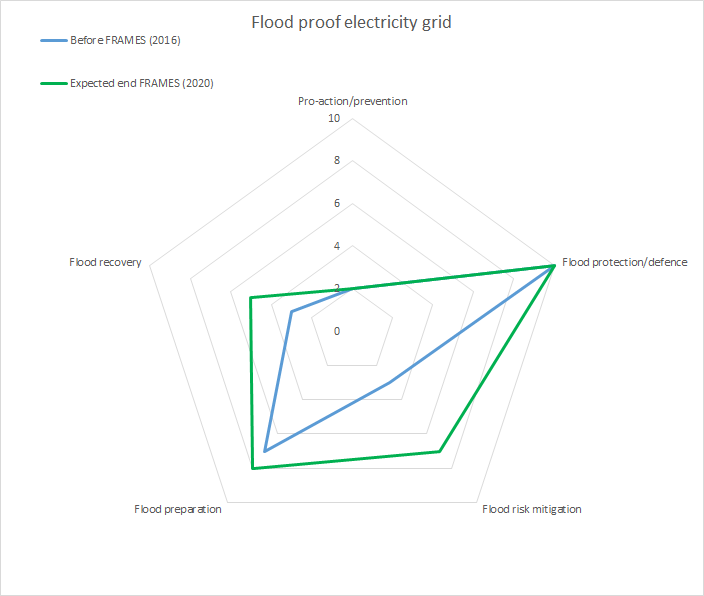Implementation process
By looking at the the activities, actors and methods or approaches used, this section will provide a better understanding of the implementation process of the MLS approach. We will describe the point of departure, who was involved (when, why and how) and what key decisions were made when and why.
Point of departure of FRM strategies
Figure 1: Current and desired score to reach per layer in the pilot (Baseline monitor, 2017)
To measure the impact of FRAMES on improving the flood resilience of pilot areas, communities and authorities both a baseline and final monitoring survey have been conducted. The surveys were completed by pilot managers in consultation with key pilot stakeholders. The baseline survey included questions about the actual situation in 2017 (before the project started) and expectations for 2020 (see figure 1). The final survey contained similar questions, but about the actual situation in 2020 and expected situation for 2025, five years after the pilot projects are finished. All the scores for both surveys along with interpretation of these scores, can be found in chapter 8 of the Transnational Monitoring and Evaluation Report.
Stakeholders involved
- Province of Zeeland
- Waterboard Scheldestromen
- Municipality Hulst
- Ministry of Infrastructure & Water Management
- TenneT
- Enduris
- Veiligheidsregio Zeeland (Zeeland Safety Region)
- Nelen&Schuurmans (consultancy firm)
- More participants of Vital & Vulnerable Infrastructure (Baseline monitor, 2017)
Roles of key actors
The Province of Zeeland was the main coordinator of the project activities.The electricity grid owners role was to provide information related the electricity assets and to consider the knowledge gain in their asset management plans. The Safety Region's role was to provide knowledge and collaborate with the Province in crisis management. The role of the municipalities was to collaborate in the process and embed the knowledge into the spatial planning policies. The National Government, in particular the Ministry responsible for electricity, i.e. the Ministry of Economic Affairs and Climate Policy, is responsible to take measures and prevent the vital services from flooding and its role is to embed the policy advise into the upcoming Nationale Omgevingsvisie 2021 (“Environmental Vision 2021”) (interview with pilot manager, 2019).
Main activities
The pilot activities refer to the data collection, data analysis and dissemination of the recommended measures.
Data collection
Stakeholders were contacted by phone, emails, individual meetings, group meetings and workshops. The first stakeholders contacted were the Safety Region, the electricity grid owners and the consultancy firm. The Safety Region has knowledge on crisis management and a large network of actors. The electricity grid owners provide information about the electricity network and the location of the electricity assets. The consultancy firm provides technical knowledge on GIS and coordinates the participation of stakeholders. The Province of Zeeland is the coordinator of the pilot implementation process. It was a challenge to communicate the low flood risk (1:4000 years) and get the attention of the electricity grid owners. The confidentiality of the (geo)information of the assets was a specific point of attention. A leading team was formed for the project including four people, one representative from each organisation. This team met every month to discuss the progress of the activities, decide on next steps, and conduct the vulnerability study (interview with pilot manager , 2019).
The data used (Nelen & Schuurmans, 2018):
- Flood scenarios (1:4000 years) from the National Database on Flood Scenarios;
- Rain induced flood data until 2050 from the Climate Effect Atlas; ground levels (AHN2);
- Location of the assets - a very important step in the process. The team had to sign a confidentiality agreement with the electricity owners to ensure that the geographical location of the electricity assets will not be published in the future. This step built trust among the parties and improved the collaboration (interview with pilot manager, 2019).
- Critical height based on the type and year of construction of each station.
Flood hazard maps
The interactive 3Di model was used to make the flood maps using as an input the previous data for vital infrastructure with different flood return periods (1:400, 1:4000, 1:40.000 and 1:400.000 years) (Nelen & Schuurmans, 2018).
The GIS modelling was carried out by the consultancy firm in 2 stages (interview with pilot manager, 2019):
- The impact of dyke breaching was studied, and
- The cascading effects of a dyke breaching to other vital services (Telecom hubs, nursing homes, institutions, fire stations and pumping stations) was analysed for the Kloosterzande area. At this stage, the stakeholder from the gas, drinking water electricity companies, water board and municipality of Hulst were involved.
Data analysis
The risk label method (Nelen & Schuurmans, 2018; the English explanation of this method can be downloaded here) was used to study direct and indirect effects of power outage failure in the network. The critical water depth considered at risk is between 20-80 cm. The risk label was calculated based on the flood risk, the importance of the electricity and the number of people affected (higher risk in cities). The risk label method was applied to the whole Province and the analysis resulted in 23 assets at high risk considering direct and indirect failure (cascading effects) of the medium-voltage network. Even though an area with electricity grid failure is not flooded directly, can still be affected indirectly by water (interview with pilot manager, 2019).
Data validation
The results were presented and validated by experts during a workshop on February 22nd, 2018. The experts involved were actors from: electricity companies (Enduris and Delta), Province of Zeeland, Municipality Hulst, Nelen & Schuurmans , Ministry of Economic Affairs and Climate Policy, Waterboard Schelderstromen, DNWG (infrastructure network), and Safety region Zeeland . It was discussed the electricity outage for households and the cascading effects to other assets. Moreover, the results of the analysis using the risk label method was presented and validated during the workshop (Nelen & Schuurmans, 2018).

